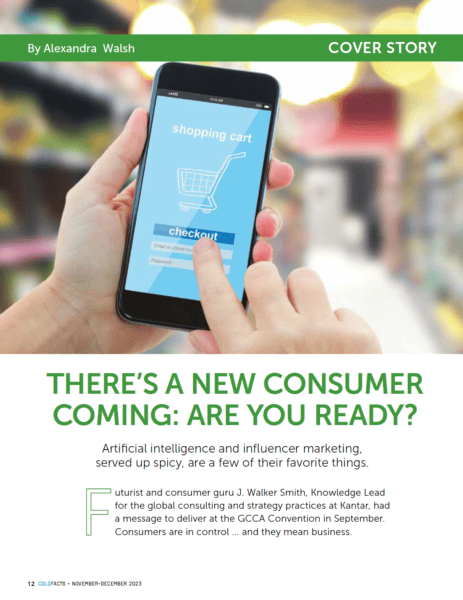From COLD FACTS Magazine (Click Image)
Read Below:
There’s A New Consumer Coming: Are You Ready?
Artificial intelligence and influencer marketing, served up spicy, are a few of their favorite things.
By Alexandra Walsh
Futurist and consumer guru J. Walker Smith, Knowledge Lead for the global consulting and strategy practices at Kantar, had a message to deliver at the GCCA Convention in September. Consumers are in control … and they mean business.
Following is an interview with Smith about attitudes and generational marketing and spicy communal eating and how they are shaping the future of the consumer marketplace.
Q: How is consumer consumption changing?
- WALKER SMITH (JWS): After the pandemic, consumption shifted back to the long-term trend of increasing spending on services. Spending has yet to fully catch up, though this will probably happen in 2024. The biggest pandemic spending boost was for non-durables, and this is where the impact will be felt going forward. Additionally, there is increasing interest in all things related to health and wellness, across all categories. As part of that, sleep-related products are a trending sub-category. Consumers are also increasingly interested in products that feel comfortable culturally. Sometimes, this spills out as politics, but it’s really just a desire to feel that brands are authentic to the ways people live. Part of this is reflected in a growing interest in culturally distinctive foods. Part of this shows up as an appreciation of local involvement by brands and retailers. And part of the trend is about ways of shopping that feel more socially engaged and interactive.
Q: What macro consumer marketing trends are you seeing?
JWS: The biggest macro trends are economics. Households have been feeling pressures but have not been under pressure. Consumers have had pandemic-accumulated savings to help them through, so far. This will become a question for next year. Hybrid digital shopping is growing with click-and-pick and omnichannel outlets. Part of this is about people spending more time at home, which is a big shift for the long term. Demographically, there is an ongoing shift in the overall mix of household types, with a relative drop in traditional family households. And then, of course, there’s artificial intelligence (AI).
Q: What are generational marketing trends, and do they apply to food consumers?
JWS: Younger generations feel greater economic pressures than prior generations at the same age. But they have been coping surprisingly well. In terms of taste, spicy foods seem to have more resonance with this group, and there is more dining as groups, so foods that fit that experience are preferred. Plant-based alternatives will grow as younger generations come into the marketplace as heads of household. Street foods, too. And portable foods for more dynamic lifestyles. Younger consumers will also rely more on AI to help them discover and buy.
Q: What is the importance of baby boomer consumers?
JWS: Boomers continue to consume. They are healthier and more numerous in both absolute and relative numbers than older consumers in the past. Boomers have lots of money and a willingness to spend it. Boomers are traveling and trying to remain active, so they are pushing marketplace trends in these directions. Perhaps most of all, classic Boomer culture still matters, such as music, old TV shows and current movies set in the 1970s.
Q: What impact do you see social media having on the way consumers discover, select, purchase and consume food?
JWS: Influencer marketing is here to stay. That’s the biggest social media impact. Additionally, negative feedback on social media can drive consumers away – often more than positive feedback can bring consumers in. Short videos are increasingly how people want to learn and be entertained. Social media has made authenticity of style and presence more important and easier to verify. But it’s not just social media as a new medium of discovery. Very soon, AI will work in conjunction with social media, and AI will take over much of the discovery and evaluation that consumers do with social media. Being AI-friendly is a new brand imperative (similar to being Google-friendly in years past).
Q: What will be the impact of AI and automation on consumer marketing trends?
JWS: The biggest impact is likely to be on how people learn about brands and products. Instead of digging in themselves, consumers are going to hand that off to AI interfaces and then decide based on what AI tells them. AI will be reading and watching as much if not more than consumers. And even when consumers read and watch, they will come to depend more and more on AI to make sense of it all.
Q: What are the costs and benefits of consumer engagement.
JWS: The biggest risk of high engagement is disappointing consumers, and this is worsened by the fact that much engagement today angers people who are frustrated with how we respond and remedy complaints. The impact on brands is negative social media, which can be punishing for brands. But the benefits of strong engagement are significant, the biggest of which is pricing power. Brands that can build a strong position with consumers command more ability to sustain and earn higher prices and thus higher margins.
Q: What will the supply chains and logistics that get products to consumers look like in the future?
JWS: I don’t know the answer to this question. But there is growing interest in products with some sort of local connection and craft products that have more of a special feel to them. Consumers are also concerned increasingly about carbon footprint, so this will be a factor as well.
Q: How do you create community and connection in the face of hyperpersonalization and polarization?
JWS: Zero in on the core mission of the brand. People will come together around the benefit a brand delivers, whatever else might be going on. The risk of alienating customers is heightened when brands broaden beyond a mission focus. This is not to say that brands should eschew purpose. Consumers have come to expect that of brands. It is merely to say that what people want most, and what brings people around a brand, is the core benefit promised by a brand.




